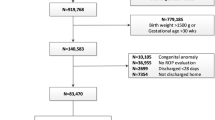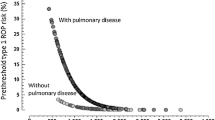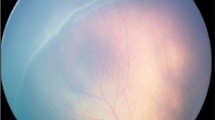Abstract
Purpose
To investigate the characteristics of outlier infants for insights into ROP risk.
Methods
Chart data were collected from 1,354 infants screened for ROP at Weill Cornell Medical Center and Columbia University Medical Center. ROP exam results and clinical risk factors were recorded. The cohort was stratified by weight, highest ROP stage, and need for ROP treatment. Descriptive and correlational statistics were performed.
Results
For the overall cohort, regression analysis found that birth weight (OR: 0.741 per 100 g; 95 % CI: 0.606, 0.905), gestational age at birth (OR: 0.563 per week; 95 % CI: 0.454, 0.697), multiple gestation (OR 2.02, 95 % CI: 1.15, 3.56), bronchopulmonary dysplasia (OR: 4.68, 95 % CI: 1.93, 11.35), and necrotizing enterocolitis (OR 2.80, 95 % CI: 1.40, 5.16) were independent risk factors for treatment-requiring ROP. Black race was found to be a protective factor for treatment-requiring ROP (OR 0.244, 95 % CI: 0.095, 0.626). Among 15 infants with BW <500 g, there were no significant differences in any clinical risk factors between the 12 (80 %) with ROP vs the three (20 %) without ROP. Similarly, among infants with BW >1500 g, the 17 (9 %) with ROP only differed from the 166 (91 %) without ROP with respect to a higher incidence of necrotizing enterocolitis among those with ROP (11.8 % vs 0 %).
Conclusions
Although known clinical risk factors were predictive of ROP stage and need for laser treatment in this cohort, they were not significantly associated with ROP at extremes of birth weight. This suggests that other clinical, maternal, or genetic factors may protect from or predispose to ROP.
Similar content being viewed by others
References
Gilbert C (2008) Retinopathy of prematurity: a global perspective of the epidemics, population of babies at risk and implications for control. Early Hum Dev 84(2):77–82
Palmer EA (1990) Results of U.S. randomized clinical trial of cryotherapy for ROP (CRYO-ROP). Doc Ophthalmol Adv Ophthalmol 74(3):245–251
Reynolds JD, Dobson V, Quinn GE et al (2002) Evidence-based screening criteria for retinopathy of prematurity: natural history data from the CRYO-ROP and LIGHT-ROP studies. Arch Ophthalmol 120(11):1470–1476
Early Treatment For Retinopathy Of Prematurity Cooperative Group (2003) Revised indications for the treatment of retinopathy of prematurity: results of the early treatment for retinopathy of prematurity randomized trial. Arch Ophthalmol 121(12):1684–1694
Supplemental Therapeutic Oxygen for Prethreshold Retinopathy Of Prematurity (STOP-ROP) (2000) A randomized, controlled trial. I: primary outcomes. Pediatrics 105(2):295–310
Fierson WM (2013) Screening examination of premature infants for retinopathy of prematurity. Pediatrics 131(1):189–195
Palmer EA, Flynn JT, Hardy RJ et al (1991) Incidence and early course of retinopathy of prematurity. The Cryotherapy for Retinopathy of Prematurity Cooperative Group. Ophthalmology 98(11):1628–1640
Kaempf JW, Kaempf AJ, Wu Y, Stawarz M, Niemeyer J, Grunkemeier G (2011) Hyperglycemia, insulin and slower growth velocity may increase the risk of retinopathy of prematurity. J Perinatol 31(4):251–257
Chiang MF, Arons RR, Flynn JT, Starren JB (2004) Incidence of retinopathy of prematurity from 1996 to 2000: analysis of a comprehensive New York state patient database. Ophthalmology 111(7):1317–1325
Isaza G, Arora S, Bal M, Chaudhary V (2013) Incidence of retinopathy of prematurity and risk factors among premature infants at a neonatal intensive care unit in Canada. J Pediatr Ophthalmol Strabismus 50(1):27-32
Mathew MRK, Fern AI, Hill R (2002) Retinopathy of prematurity: are we screening too many babies? Eye (Lond) 16(5):538–542
Lad EM, Hernandez-Boussard T, Morton JM, Moshfeghi DM (2009) Incidence of retinopathy of prematurity in the United States: 1997 through 2005. Am J Ophthalmol 148(3):451–458
Moral-Pumarega MT, Caserío-Carbonero S, De-La-Cruz-Bértolo J, Tejada-Palacios P, Lora-Pablos D, Pallás-Alonso CR (2012) Pain and stress assessment after retinopathy of prematurity screening examination: indirect ophthalmoscopy versus digital retinal imaging. BMC Pediatr 12:132
Belda S, Pallás CR, De la Cruz J, Tejada P (2004) Screening for retinopathy of prematurity: is it painful? Biol Neonate 86(3):195–200
Mitchell AJ, Green A, Jeffs DA, Roberson PK (2011) Physiologic effects of retinopathy of prematurity screening examinations. Adv Neonatal Care Off J Natl Assoc Neonatal Nurses 11(4):291–297
Rush R, Rush S, Nicolau J, Chapman K, Naqvi M (2004) Systemic manifestations in response to mydriasis and physical examination during screening for retinopathy of prematurity. Retina 24(2):242–245
Wright K, Anderson ME, Walker E, Lorch V (1998) Should fewer premature infants be screened for retinopathy of prematurity in the managed care era? Pediatrics 102(1 Pt 1):31–34
Andruscavage L, Weissgold DJ (2002) Screening for retinopathy of prematurity. Br J Ophthalmol 86(10):1127–1130
Hutchinson AK, O’Neil JW, Morgan EN, Cervenak MA, Saunders RA (2003) Retinopathy of prematurity in infants with birth weights greater than 1250 grams. J AAPOS 7(3):190–194
Seiberth V, Linderkamp O (2000) Risk factors in retinopathy of prematurity. a multivariate statistical analysis. Ophthalmologica 214(2):131–135
Schaffer DB, Palmer EA, Plotsky DF et al (1993) Prognostic factors in the natural course of retinopathy of prematurity. The Cryotherapy for Retinopathy of Prematurity Cooperative Group. Ophthalmology 100(2):230–237
Binenbaum G, Ying G-S, Quinn GE et al (2012) The CHOP postnatal weight gain, birthweight and gestational age retinopathy risk model. Arch Ophthalmol 130(12):1560–1565
Hardy RJ, Palmer EA, Dobson V et al (2003) Risk analysis of prethreshold retinopathy of prematurity. Arch Ophthalmol 121(12):1697–1701
Löfqvist C, Hansen-Pupp I, Andersson E et al (2009) Validation of a new retinopathy of prematurity screening method monitoring longitudinal postnatal weight and insulinlike growth factor I. Arch Ophthalmol 127(5):622–627
Anon (2001) Screening examination of premature infants for retinopathy of prematurity. Pediatrics 108(3):809–811
Anon (2006) Screening examination of premature infants for retinopathy of prematurity. Pediatrics 117(2):572–576
Good WV, Early Treatment for Retinopathy of Prematurity Cooperative Group (2004) Final results of the Early Treatment for Retinopathy of Prematurity (ETROP) randomized trial. Trans Am Ophthalmol Soc 102:233–248, discussion 248–250
Lang DM, Blackledge J, Arnold RW (2005) Is Pacific race a retinopathy of prematurity risk factor? Arch Pediatr Adolesc Med 159(8):771–773
Yang MB, Donovan EF, Wagge JR (2006) Race, gender, and clinical risk index for babies (CRIB) score as predictors of severe retinopathy of prematurity. J AAPOS 10(3):253–261
Haroon Parupia MF, Dhanireddy R (2001) Association of postnatal dexamethasone use and fungal sepsis in the development of severe retinopathy of prematurity and progression to laser therapy in extremely low-birth-weight infants. J Perinatol 21(4):242–247
Aralikatti AKV, Mitra A, Denniston AKO, Haque MS, Ewer AK, Butler L (2010) Is ethnicity a risk factor for severe retinopathy of prematurity? Arch Dis Child Fetal Neonatal Ed 95(3):174–176
Saunders RA, Donahue ML, Christmann LM et al (1997) Racial variation in retinopathy of prematurity. The Cryotherapy for Retinopathy of Prematurity Cooperative Group. Arch Ophthalmol 115(5):604–608
Shastry BS (2010) Genetic susceptibility to advanced retinopathy of prematurity (ROP). J Biomed Sci 17:69
Hiraoka M, Takahashi H, Orimo H, Hiraoka M, Ogata T, Azuma N (2010) Genetic screening of Wnt signaling factors in advanced retinopathy of prematurity. Mol Vis 16:2572–2577
Ells A, Guernsey DL, Wallace K et al (2010) Severe retinopathy of prematurity associated with FZD4 mutations. Ophthalmic Genet 31(1):37–43
Holmström G, van Wijngaarden P, Coster DJ, Williams KA (2007) Genetic susceptibility to retinopathy of prematurity: the evidence from clinical and experimental animal studies. Br J Ophthalmol 91(12):1704–1708
Funding Support
Supported by grant EY19474 from the National Institutes of Health (Bethesda, MD, USA) (MFC), NIH/NEI EY010572 (DC), and by unrestricted departmental funding from Research to Prevent Blindness (New York, NY, USA) (ADP, RVPC, SO, MFC). Financial support from Fight For Sight (New York, NY, USA) (ADP) is gratefully acknowledged.
Financial Disclosures
MFC is an unpaid member of the Scientific Advisory Board for Clarity Medical Systems (Pleasanton, CA, USA).
Contributions of Authors
Design and conduct of the study (AP, RVPC, MFC); collection and management of data (AP, SO); analysis and interpretation of the data (AP, RVPC, DC, MFC); preparation and review of the manuscript (AP, RVPC, SO, DC, MFC).
Author information
Authors and Affiliations
Corresponding author
Rights and permissions
About this article
Cite this article
Port, A.D., Chan, R.V.P., Ostmo, S. et al. Risk factors for retinopathy of prematurity: insights from outlier infants. Graefes Arch Clin Exp Ophthalmol 252, 1669–1677 (2014). https://doi.org/10.1007/s00417-014-2716-1
Received:
Revised:
Accepted:
Published:
Issue Date:
DOI: https://doi.org/10.1007/s00417-014-2716-1




